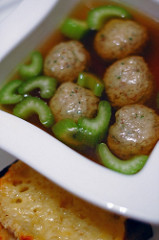Bone Marrow Dumplings in Consommé

Marrow dumplings in consommé
Photo by Melissa Schneider.
I still remember the first time I made bone marrow dumplings, an idea from the Austrio-Hungarian cookbook East of Paris. I forgot to add eggs to bind the dumpling mixture, and the pretty balls of bread crumbs and bone marrow disintegrated into the consommé I had made, transforming the crystal-clear liquid into a muddy broth.
When I spotted marrow bones at Prather Ranch's farmers' market stall, I decided to climb back on that horse, even if the bones came from a cow. I bought two packages and scraped the pink, chalk-like substance from one set of frozen bones before placing them in the stockpot. The second set awaits an ogreish feast of marrow-sucking straight from roasted bones.
The dumplings came together quickly. I sliced stale bread into cubes, sautéed them in butter, and puréed the croutons in my food processor. I added the bone marrow, the eggs—don't forget the eggs—and seasoned with minced carrot tops, pepper, and salt. The thick paste looked promising, but I decided to cook the dumplings in salted water instead of the consommé, just in case.
When you poach dumplings, kitchen wisdom says to remove them from the water shortly after they float to the surface, buoyed aloft by the steam of vaporized water inside the dough's air pockets. These dumplings sprang to the top of the pot in 20 seconds or so, hinting at the airiness we later noticed as they melted on our tongue in a warm explosion. The marrow added richness to the morsels, and the lightly cooked celery and carrots added crunch. Cheddar cheese melted on toast rounded out our simple evening meal.
Wine Notes
It's hard to pair soup with wine, because the subtle flavors disappear under the onslaught of sensations that wine provides: acidity, tannins, and aromas. But this dish, with its meaty consommé, crisp vegetables, rich marrow dumplings, and toasted cheese side, can stand up for itself as long as the wine is restrained. In this case, the dish has such a strong tie to a European culture—Austria—that I looked for regional wines that have evolved alongside the cuisine. I chose a Burgenland Blaufränckish. It was a lean wine, not lush, with its own subtle flavors. Low alcohol kept the wine light, so it wouldn't overpower the soup, which I tarted up with red wine vinegar to give it a touch of acidity.
- Shanghai Dumpling King Restaurant Review
The Chinese are masterful when it comes to dumplings. You can enjoy an amazing variety of dumplings in just one sitting when you eat at a dim sum restaurant. But there are other types of Chinese restaurants that specialize in dumplings and serve them...
- Technique: Chicken Rillettes
I often buy a whole chicken for a week’s worth of dinners. The first two meals are easy: something with the legs and then something with the breasts. But what about the wings? There’s not much meat on them; certainly not enough for a main...
- Our Last Dinner Party
We hosted our last dinner party one week ago. No, not really. But it was the last dinner party we’re likely to have in our apartment. Sniff. It’s held a fair number of parties, and it’s a nice space — the dining room is gigantic...
- Vinegar-braised Pork Shoulder
Until you taste it, there is little to recommend vinegar-braised pork shoulder. The steam from the pot, heavy with acetic acid, burns the eyes of the cook who checks on it. And stews rarely allow for pretty presentation. But after two hours of slow cooking,...
- Wtn: 2005 Wölffer Estate Rosé, The Hamptons, New York, Usa
Every year in the late spring, wine publications run features that sing the praises of rosé wines. Every year, I wonder if anyone still believes that rosés are off-balance sweet wines in the manner of White Zinfandel. But I was out to dinner...
